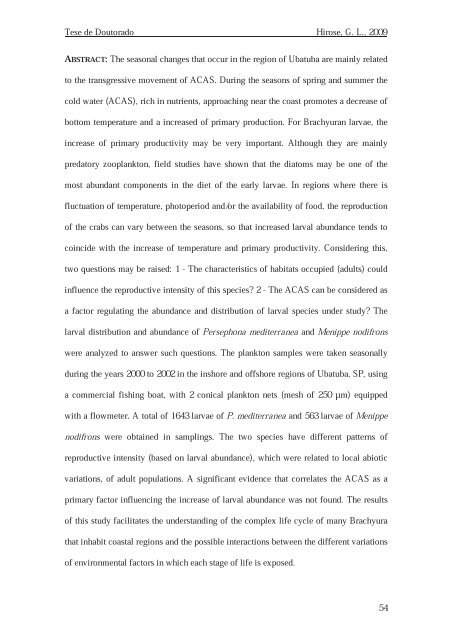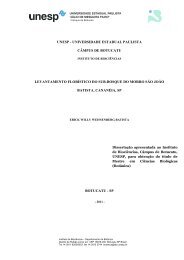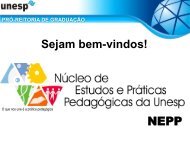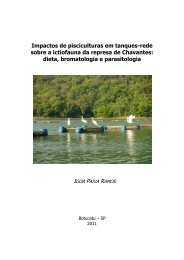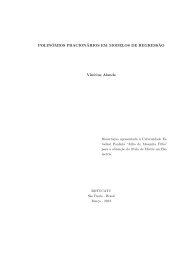Visualizar Tese - Instituto de Biociências - Unesp
Visualizar Tese - Instituto de Biociências - Unesp
Visualizar Tese - Instituto de Biociências - Unesp
Create successful ePaper yourself
Turn your PDF publications into a flip-book with our unique Google optimized e-Paper software.
<strong>Tese</strong> <strong>de</strong> Doutorado Hirose, G. L., 2009<br />
ABSTRACT:The seasonal changes that occur in the region of Ubatuba are mainly related<br />
to the transgressive movement of ACAS. During the seasons of spring and summer the<br />
cold water (ACAS), rich in nutrients, approaching near the coast promotes a <strong>de</strong>crease of<br />
bottom temperature and a increased of primary production. For Brachyuran larvae, the<br />
increase of primary productivity may be very important. Although they are mainly<br />
predatory zooplankton, field studies have shown that the diatoms may be one of the<br />
most abundant components in the diet of the early larvae. In regions where there is<br />
fluctuation of temperature, photoperiod and/or the availability of food, the reproduction<br />
of the crabs can vary between the seasons, so that increased larval abundance tends to<br />
coinci<strong>de</strong> with the increase of temperature and primary productivity. Consi<strong>de</strong>ring this,<br />
two questions may be raised: 1 - The characteristics of habitats occupied (adults) could<br />
influence the reproductive intensity of this species? 2 - The ACAS can be consi<strong>de</strong>red as<br />
a factor regulating the abundance and distribution of larval species un<strong>de</strong>r study? The<br />
larval distribution and abundance of Persephona mediterranea and Menippe nodifrons<br />
were analyzed to answer such questions. The plankton samples were taken seasonally<br />
during the years 2000 to 2002 in the inshore and offshore regions of Ubatuba, SP, using<br />
a commercial fishing boat, with 2 conical plankton nets (mesh of 250 µm) equipped<br />
with a flowmeter. A total of 1643 larvae of P. mediterranea and 563 larvae of Menippe<br />
nodifrons were obtained in samplings. The two species have different patterns of<br />
reproductive intensity (based on larval abundance), which were related to local abiotic<br />
variations, of adult populations. A significant evi<strong>de</strong>nce that correlates the ACAS as a<br />
primary factor influencing the increase of larval abundance was not found. The results<br />
of this study facilitates the un<strong>de</strong>rstanding of the complex life cycle of many Brachyura<br />
that inhabit coastal regions and the possible interactions between the different variations<br />
of environmental factors in which each stage of life is exposed.<br />
54


